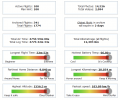No Video due to inappropriate flight test of a mav 3. Flight started from home point at 4 AM. 4 AM was chosen because most manned aircraft and ground activity is especially limited. This is no excuse for the test. The test consisted of flying straight up from home point in sport mode to 1000 ft over a suburb area. 1000 ft was selected in order to prevent ground structure and tree interference. The flight was a straight line until the battery hit 50%. This is when the Mavic 3 hit 24,000 ft (4.55 miles) from its home point.
At 4.55 miles drone was turned around to home to avoid possible head wind gusts causing undesired early battery power loss.
While flying home the drone was commanded to slowly drop altitude, thus increasing its speed up to 47mph most of the flight. The duration of the flight was not timed. Drone landed at home point with 18% battery. Battery readout was still showing green status. Landed at home point with no forced landing. Only one time did the drone try to auto initiate RTH. This was quickly cancelled, then manual flight was re-initiated. The Mavic 3 is an incredible machine. No such flights were ever performed again, and will not be done again. This was a one time test.
Test performed with an Alientech Power Amplified RC modification on an RC N1.
PIC not Identified.
At 4.55 miles drone was turned around to home to avoid possible head wind gusts causing undesired early battery power loss.
While flying home the drone was commanded to slowly drop altitude, thus increasing its speed up to 47mph most of the flight. The duration of the flight was not timed. Drone landed at home point with 18% battery. Battery readout was still showing green status. Landed at home point with no forced landing. Only one time did the drone try to auto initiate RTH. This was quickly cancelled, then manual flight was re-initiated. The Mavic 3 is an incredible machine. No such flights were ever performed again, and will not be done again. This was a one time test.
Test performed with an Alientech Power Amplified RC modification on an RC N1.
PIC not Identified.












